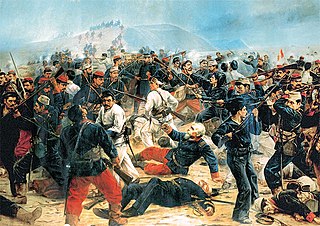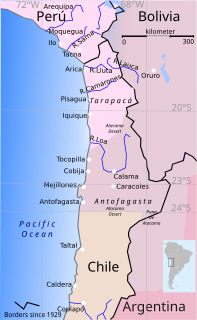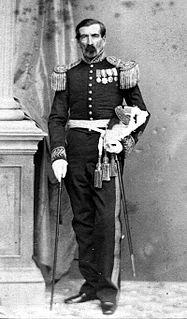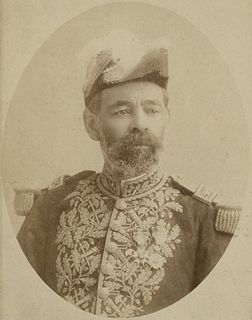
In the Battle of Monterrey during the Mexican–American War, General Pedro de Ampudia and the Mexican Army of the North was defeated by the Army of Occupation, a force of United States Regulars, Volunteers and Texas Rangers under the command of General Zachary Taylor.

The 1st Commonwealth Division was the name given, after July 1951, to Commonwealth land forces in the Korean War. The division was a multinational unit that was part of British Commonwealth Forces Korea, and whilst British and Canadian Army units formed the bulk of the division, Australian infantry, New Zealand artillery and an Indian medical unit were also a part of the division. As with the US "KATUSA" programme, numerous South Korean troops were seconded to the Commonwealth division to make up numbers under a programme known as "KATCOM".

The 1st Infantry Division was a regular army infantry division of the British Army with a very long history. The division was present at the Peninsular War, the Crimean War, the First World War, and during the Second World War and was finally disbanded in 1960.

The Structure of the Argentine Army is made up of administrative branches and the field organisation of three divisions and the parachute brigade which is part of the Rapid Deployment Force.

The Battle of Arica, also known as Assault and Capture of Cape Arica, was a battle in the War of the Pacific. It was fought on 7 June 1880, between the forces of Chile and Peru.

This is the order of battle for both the Russian and German armies at the Battle of Tannenberg, August 17 to September 2, 1914.

The Battle of Huamachuco was fought on the 10 July 1883, and it was the last major battle of the War of the Pacific. The Chilean soldiers led by Colonel Alejandro Gorostiaga decisively defeated the Peruvian army commanded by General Andrés Avelino Cáceres near the town of Huamachuco. This Chilean victory effectively eliminated Cáceres' Ejército de la Breña, ending any real threat or resistance in the Peruvian Andes. The Peruvian defeat paved the way for the Treaty of Ancon that finally put an end to the war. Also, one of Peru's greatest heroes, Colonel Leoncio Prado, died as a consequence of this battle.

Below is an estimated list of the major units deployed within the Multi-National Force - Iraq and other United States military units that were operating in Iraq under the U.S. Central Command (USCENTCOM) in 2009, during the Iraq War.

The 1st Guards Infantry Division was a unit of the Prussian Imperial German Army and was stationed in Berlin.

The Malaya Command was a formation of the British Army formed in the 1920s for the coordination of the defences of British Malaya, which comprised the Straits Settlements, the Federated Malay States and the Unfederated Malay States. It consisted mainly of small garrison forces in Kuala Lumpur, Penang, Taiping, Seremban and Singapore.

The Battle of Miraflores occurred on January 15, 1881 in the Miraflores District of Lima, Peru. It was an important battle during the War of the Pacific that was fought between Chile and the forces of Peru. The Chilean army led by Gen. Manuel Baquedano defeated the army commanded by Nicolás de Piérola guarding the second defensive line of the Peruvian capital city. Two days later, Lima, the capital city of Peru was occupied by Chilean troops. Gen. Baquedano's forces marched into Lima triumphant, while Peru's president and his officers fled into the interior, leaving the country without any government. Even after the fall of Lima, the war continued between the occupation army and the troops of Andres Caceres for another three years. During the occupation of Lima, Peru's National Library was burned, while a number of other monuments were ransacked by Chilean forces and taken as war trophies.

The 142nd Field Artillery Regiment is a United States Army field artillery regiment currently represented in the Arkansas Army National Guard by the 1st Battalion, 142nd Field Artillery, headquartered in Harrison, Arkansas; 2nd Battalion, 142nd Field Artillery, headquartered in Fort Smith, Arkansas; and Battery F, 142nd Field Artillery stationed in Fayetteville, Arkansas, elements of the 142nd Field Artillery Brigade which is headquartered in Fayetteville, Arkansas. The regiment was created in 1917 from the former 2nd Arkansas Infantry. The 142nd Field Artillery shipped to France during World War I, but did not see combat before cessation of hostilities. The regiment was activated for World War II, but its battalions were redesignated as separate battalions, 1–142nd became the 936th Field Artillery Battalion, the 2–142nd became the 937th Field Artillery Battalion. The battalion's served throughout the European Theater of Operations. The battalions were activated again for the Korean War and served throughout the war. Following the Korean War the separate battalions resumed their former designations of 1–142nd FA and 2–142nd FA. The 142nd Field Artillery Brigade, including both battalions was activated for Operation Desert Storm. Elements of the 142nd Fires Brigade have been activated for service in Operation Noble Eagle and Operation Iraqi Freedom. The 142nd Fires Brigade was instrumental in support and recovery operations located in New Orleans, Louisiana after hurricanes Katrina and Rita devastated the Gulf Coast.
This is an order of battle of the French and German Armies at the beginning of the Franco-Prussian War in 1870.

The Battle of Tacna, also known as the Battle of the Peak of the Alliance, effectively destroyed the Peru-Bolivian alliance against Chile, forged by a secret treaty signed in 1873. On May 26, 1880, the Chilean Northern Operations Army led by General Manuel Baquedano González, conclusively defeated the combined armies of Peru and Bolivia commanded by Bolivian President, General Narciso Campero. The battle took place at the Inti Urqu (Intiorko) hill plateau, a few miles north of the Peruvian city of Tacna. As a result, Bolivia was knocked out of the war, leaving Peru to fight the rest of the war alone. Also, this victory consolidated the Chilean domain over the Tarapacá Department. The territory was definitively annexed to Chile after the signing of the Tratado de Ancón, in 1884, which ended the war. Tacna itself remained under Chilean control until 1929.

The 1st Infantry Regiment "Los Patricios" is the oldest and one of the most prestigious regiments of the Argentine Army. The title is often shortened to the Patricians' Regiment. Since the 1990s the regiment has been designated as air assault infantry. It is also the custodian of the Buenos Aires Cabildo, the welcoming party for visiting foreign dignitaries to Argentina and the escort and honor guard battalion for the City Government of Buenos Aires. Since 22 September 2010, the Regiment's headquarters building has been a National Historical Monument following a declaration by the Argentine government on the occasion of the country's bicentennial year.
This is the order of battle for the ground forces involved in Operation Crusader, a World War II battle between the British Commonwealth and the European Axis Powers of Germany and Italy in North Africa between 18 November – 30 December 1941.
The Battle at Tacna was an engagement during the War of the Pacific (1879–1883) between Chile and the Allied Forces of Peru and Bolivia. It was fought on May 20, 1880, with the forces aligned as follows:
The Pakistani plan for a military action which commenced on March 25, 1971 in the then East Pakistan was code-named Operation Searchlight. This is the Operation Searchlight order of battle which was outlined on March 19, 1971 by Major General Khadim Hussain Raja, GOC 14th infantry division, and Major General Rao Farman Ali in the GHQ of Pakistan Army in Dhaka, (then)East Pakistan.
The following is the order of battle of the Hellenic Army during the First Balkan War.





















